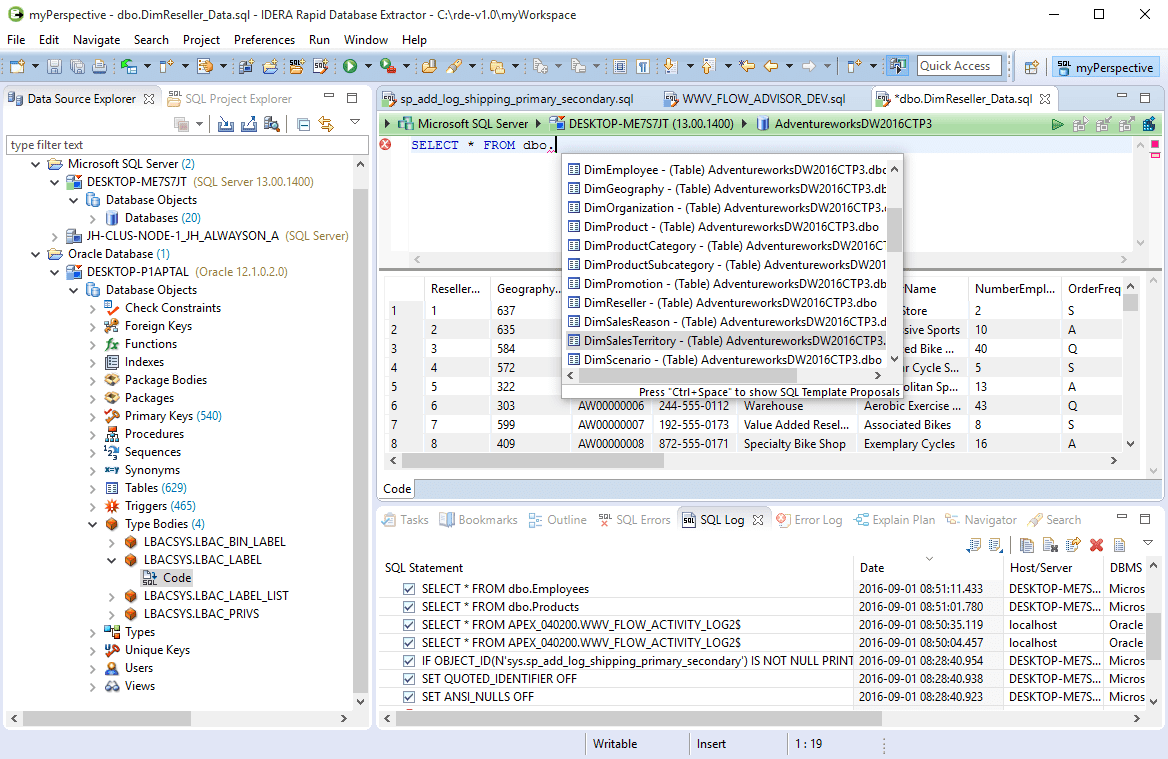Free Tool – Rapid Database Extractor
Explore and manipulate database objects and data
Database Management for SQL Server, Amazon RDS for SQL Server, and Oracle Database
By exploring database objects, understanding their structure and dependencies, users can effectively manage and maintain data consistency, integrity, and accuracy.
Download the free tool Rapid Database Extractor now!
Manage SQL Server and Oracle data sources
Manipulate database objects
Interactively edit SQL code
Export data to common file formats
Connect to cloud and run in cloud (provisional)
Tech Specs
- Microsoft Windows: Vista, Server 2008, 7, Server 2008 R2, 8, Server 2012, 8.1, Server 2012 R2, Server 2012 R2 Update, 10; plus Server 2016, Server 2019, 11, Server 2022 (provisional); 64-bit, 32-bit
- Microsoft .NET Framework: 4.0 and later
- Java Runtime Environment: 1.8+ (64-bit Rapid Database Extractor requires 64-bit Java; 32-bit Rapid Database Extractor requires 32-bit Java)
- web browser: Microsoft Internet Explorer 10.x+ (minimum of Windows 7 SP1, Server 2008 R2 SP1), Microsoft Edge, Google Chrome, Mozilla Firefox
Database Platforms
- Microsoft SQL Server: 2008 R2, 2012, 2014, 2016; plus 2017, 2019, 2022 (provisional); Windows, Linux (provisional); Express, Standard, Enterprise Editions
- Oracle Database: 9i, 10g, 11g, 12c; plus 18c, 19c, 21c, 23c (provisional)
Databases in the Cloud
- Microsoft Azure: Virtual Machine (VM)
- Amazon Web Services: Elastic Compute Cloud (EC2), Relational Database Service (RDS) for SQL Server
- connection: DNS domain name, IP address; SQL Authentication, Windows Active Directory
Agentless
- Rapid Database Extractor does not install any components, dynamic link libraries (DLLs), scripts, stored procedures, or tables on the managed database instances.
Manage SQL Server and Oracle Data Sources
Connect to SQL Server and Oracle data sources from a single user interface. Register data sources manually or semi-automatically. Log in to multiple data sources. Drill down into the data sources to view registered databases on each server.
Manipulate Database Objects
Drill down into each database to display its objects and to inspect the structure of individual objects for quick visibility into databases. Navigate and search objects, create new objects, edit existing objects, execute context-sensitive commands, and browse outline views without SQL script. Manage database objects, including tables, constraints, indexes, views, procedures, functions, triggers, and packages. Efficiently navigate databases with many objects.
Interactively Edit SQL Code
Edit SQL code in the interactive development environment. Select from a list of context-sensitive suggestions for object and function names, and automatically insert SQL statements from templates to avoid looking up, memorizing, and typing. Prevent and fix common mistakes with SQL code quality markers. Validate SQL syntax and semantics in real-time to avoid parser violations and unresolved references. Automatically format displayed SQL code for easy navigation. Apply and share custom SQL formatting profiles for consistent SQL code layout. Improve queries by viewing the SQL query execution plan.
Selectively Execute SQL Queries to Retrieve Data
Associate SQL files with data sources, specify SQL session options, and selectively execute SQL statements in the integrated environment to quickly manipulate database content. Display the resulting data in a convenient grid. View logs of all executed SQL queries to analyze and document past actions.
Export Data to Common File Formats
Save extracted data to standard file formats (Excel, HTML, XML, delimited TXT, and SQL INSERT statements) for subsequent analysis and collaboration.
Connect to Cloud and Run in Cloud (Provisional)
Connect to database instances hosted in the cloud, such as SQL Server on Azure Virtual Machine (VM), SQL Server on Amazon Elastic Compute Cloud (EC2), and SQL Server on Amazon Relational Database Service (RDS).
Run on virtual machines hosted in the cloud, such as Windows on Azure Virtual Machine (VM) and Windows on Amazon Elastic Compute Cloud (EC2).
* Work on databases on-premises and in the cloud, and without installing anything on the affected instances.
